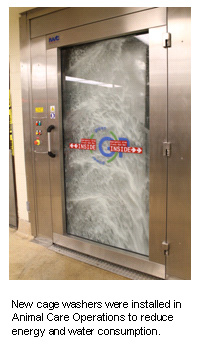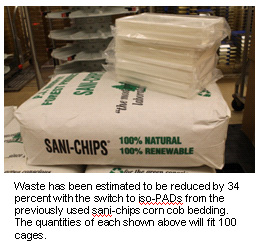
ANIMAL CARE OPERATIONS UPGRADES FACILITIES TO SAVE WATER, ENERGY
AND REDUCE WASTE
 Here
at the university, there is important research conducted on a
daily basis, and critical to that effort is Animal Care
Operations. The Animal Care Operations staff takes care of
animals and the animal facilities that support the university�s
research effort in psychology, cardiac care, cancer and
optometry. The team works day in and day out to make sure the
animals are provided feed and water as well as an environment
that is clean and safe. The facilities are top notch and
compliant with all government regulations. Now, the team has
taken the next step to improve the facilities to make it more
sustainable by replacing older equipment and changing their
processes to save water, energy and drastically reduce waste. Here
at the university, there is important research conducted on a
daily basis, and critical to that effort is Animal Care
Operations. The Animal Care Operations staff takes care of
animals and the animal facilities that support the university�s
research effort in psychology, cardiac care, cancer and
optometry. The team works day in and day out to make sure the
animals are provided feed and water as well as an environment
that is clean and safe. The facilities are top notch and
compliant with all government regulations. Now, the team has
taken the next step to improve the facilities to make it more
sustainable by replacing older equipment and changing their
processes to save water, energy and drastically reduce waste.
David Brammer, Executive Director for Animal Care Operations,
said the first improvement was made to the facilities in October
2011 with the replacement of the
cage-washing system. The previous cage-washing system included a
tunnel washer and a rack washer that were originally installed
in 1978. These washers required continuous water to run
throughout the day, five days a week. Brammer said they estimate
that one of these machines used approximately 1,200 gallons of
water a day which had to be heated to 190 degrees. Both older
machines were replaced by one Green Power rack washer which uses
only 500 gallons per day for three and a half days out of the
week. The 500 gallons of water is also heated but only has to
reheat 26 gallons for each new wash. This new system is saving a
significant amount of energy and water for the university.
This month, all of the mice cages and racks will also be
replaced to reduce energy use and waste. Corn cob bedding, which
was used to line the bottom of the cages, will now be replaced
with iso-PAD bedding, a medical grade lightweight cotton pad.
�The corn cob bedding, which can have either fertilizer residue
or pesticide residue, is being replaced to eliminate this
influence on the research. The highly processed cotton fibers do
not have these residues and is much lighter. The added advantage
of being light weight means that less waste is disposed of in
the dumpsters,� Brammer said.
 Brammer
estimates that once the new cages are in place, waste will be
reduced by 34 percent. Also, the new caging system requires less
space. A room that previously held 256 cages will now
accommodate 700 of the new cages. Brammer
estimates that once the new cages are in place, waste will be
reduced by 34 percent. Also, the new caging system requires less
space. A room that previously held 256 cages will now
accommodate 700 of the new cages.
�The caging system selected is the highest density caging system
available on the market. We can house more mice in less space.
This eliminates the need to build a new animal facility to
accommodate the increasing demands for mice in research,�
Brammer said.
The new caging system also uses the existing building exhaust
system to pull air through the cages. The previous caging system
required the use of separate blowers. The use of energy to run
the blowers will now be eliminated with the new system.
Even after all the enhancements to the caging areas, Animal Care
Operations decided to make an additional change to their
cleaning supplies and purchased mops that will require less
water and chemicals. The new mops use a micro fiber pad system
which is able to utilize only one gallon of diluted sanitizing
chemicals for up to 25 pads. The water in the mop buckets is not
contaminated by dirty mops as it is with conventional systems.
This allows the staff to use the solution in the buckets until
all of the water is utilized. This eliminates the need to dump
the water buckets and therefore saves approximately 100 gallons
of diluted chemicals from being dumped into the drains each day.
These enhancements at the Animal Care Operations are another way
that academic research and sustainable practices at UH are
improving the waste impact on the planet. For more information
on Animal Care Operations, visit the
Division of Research website.
For more information on the Office of Sustainability, visit
www.uh.edu/green.
|
